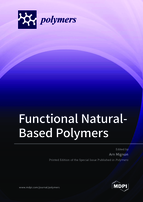Functional Natural-Based Polymers
A special issue of Polymers (ISSN 2073-4360). This special issue belongs to the section "Biomacromolecules, Biobased and Biodegradable Polymers".
Deadline for manuscript submissions: closed (31 March 2022) | Viewed by 149605
Special Issue Editor
Interests: smart polymers; polysaccharides; biomaterials; pH-responsive systems; temperature- responsive systems; enzyme-responsive systems; toxin-responsive systems; superabsorbent polymers; hydrogels; self-healing; wound healing; tendon repair; dental repair; cardiovascular applications; diabetics
Special Issues, Collections and Topics in MDPI journals
Special Issue Information
Dear colleagues,
Natural polymers are already used for a variety of biomedical applications, including drug delivery, wound healing, tissue engineering, biosensors, etc. However, they have also found other applications, for example, in the food industry, the pharmaceutical industry, as firefighting materials, water purification ... Different polysaccharide and protein-based systems have been developed. They each have their properties rendering them useful for certain applications such as the water solubility of alginate, the thermo-sensitivity of chitosan, the abundance of cellulose and starch, or the cell adhesion and proliferation of gelatin and collagen. This Special Issue will explore the design, synthesis, processing, characterization, and applications of new functional natural-based polymers. Considering your prominent contributions to this field, I would like to cordially invite you to submit an article to this Special Issue. This Special Issue will publish full research papers, communications, and review articles. I would like to bring together a collection of comprehensive articles from leading experts and up-to-date research from notable groups in the community.
Prof. Dr. Arn Mignon
Guest Editor
Manuscript Submission Information
Manuscripts should be submitted online at www.mdpi.com by registering and logging in to this website. Once you are registered, click here to go to the submission form. Manuscripts can be submitted until the deadline. All submissions that pass pre-check are peer-reviewed. Accepted papers will be published continuously in the journal (as soon as accepted) and will be listed together on the special issue website. Research articles, review articles as well as short communications are invited. For planned papers, a title and short abstract (about 100 words) can be sent to the Editorial Office for announcement on this website.
Submitted manuscripts should not have been published previously, nor be under consideration for publication elsewhere (except conference proceedings papers). All manuscripts are thoroughly refereed through a single-blind peer-review process. A guide for authors and other relevant information for submission of manuscripts is available on the Instructions for Authors page. Polymers is an international peer-reviewed open access semimonthly journal published by MDPI.
Please visit the Instructions for Authors page before submitting a manuscript. The Article Processing Charge (APC) for publication in this open access journal is 2700 CHF (Swiss Francs). Submitted papers should be well formatted and use good English. Authors may use MDPI's English editing service prior to publication or during author revisions.
Keywords
- polysaccharide
- protein
- modification
- biomedical
- food







